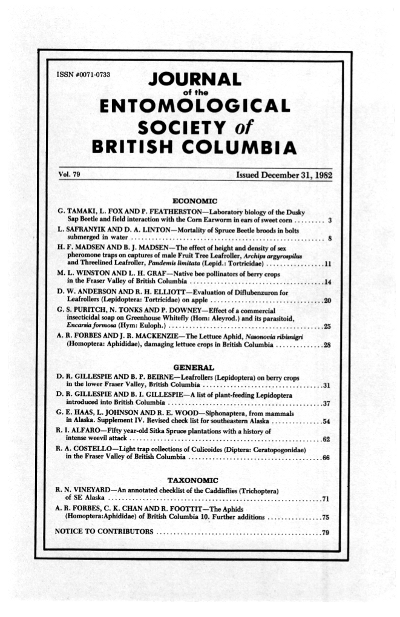Native bee pollinators of berry crops in the Fraser Valley of British Columbia
Keywords:
honeybee, <i>Apis</i>) spp., native bees, pollination, blueberry, cranberry, , raspberryAbstract
Collections of native bees were made on blueberry, cranberry, and raspberry fields in the Fraser Valley of southwestern British Columbia to determine whether these bees were present in sufficient diversity and abundance to pollinate berry crops. Bumblebees were present on all three crops but not abundant, and solitary bees were notably scarce. Native bees did not appear to be present in sufficient abundance to effect pollination of any of the berry crops, so that managed honeybees (<i>Apis mellifera</i>) are essential for berry production in the Fraser Valley. Reasons for low diversity and abundance of native bees probably included pesticide impact, habitat destruction, competition with managed honeybees, and extended rains during the study period.References
Akre, R. and H.C. Reed. 1981, Population cycles of yellowjackets (Hymenoptera: Vespinae) in the Pacific Northwest. Envir. Entomol. 10:267-274.
Anderson, D.W. and G.W. Eaton. 198]. Cranberry pollination in British Columbia. Cranberries 45:6, 12.
Berry Production Guide. 1980. Ministry of Agriculture, Province of British Columbia, Victoria, B.C.
Daubeny, H. 1971. Self-fertility in red raspberry cultivars and selections. J. Am. Soc. Hort. Sci. 588:591.
Dorr, J. and E.C. Martin. 1966. Pollination studies on the highbush blueberry Vaccinium corymbosum L. Q. Bull. Mich. State Univ. Agric. Expt. Sta. 48:437-448.
Eaton, G.W. and M.G. Stewart. 1969. Blueberry blossom damage caused by bumblebees. Canadian Entomologist 101:149-150.
Finnamore, A.T. and M.E. Neary, 1978. Blueberry pollinators of Nova Scotia, with a checklist of the blueberry pollinators in Eastern Canada and Northeastern United States. Ann. Soc. Entomol. Quebec 23:168-181.
Free, J.B. 1970. Insect Pollination of Crops. Academic Press. New York.
Johansen, C. 1980. How to reduce bee poisoning from pesticides. Western Regional Extension Publication 15:1-8.
Johansen, C. and C. Shawa. 1974. Honey bees increase cranberry production. Cooperative Extension Service No. 3468, Washington State University.
Kevan, P.G. 1975. Forest application of the insecticide fenitrothion and its effect on wild bee pollinators (Hymenoptera: Apoidea) of low bush blueberry (Vaccinium sp.) in Southern New Brunswick, Canada. Biol. Conserv. 7:301-309.
Kevan, P.G. 1977. Blueberry crops in Nova Scotia and New Brunswick — pesticides and crop reductions. Can. J. Agric. Econ. 25:61-65.
Kevan, P.G. and W.E. LaBerge. 1978. Demise and recovery of native pollinator populations through pesticide use and some economic implications. Proc. IV Int. Symp. Pollination. Md. Agric. Exp. Sta. Spec. Misc. Publ. 1:489-508.
Martin, E.C. 1966. Honey bee pollination of the highbush blueberry. American Bee J. 106:366-367.
Marucci, P.E. 1966. Blueberry pollination. American Bee J. 106:250-252, 264.
Marucci, P. 1967. Pollination of the cultivated highbush blueberry in New Jersey. Inter. Soc. Hort. Science Sump. Venlo, Netherlands. pp. 155-162.
Marucci, P.E. and H.J. Moulter. 1977. Blueberry pollination in New Jersey. Acta Horticulturae 61:175-186.
McCutcheon, D. 1976. Raspberry pollination trials. Proc. Lower Mainland Hort. Improvement Assoc. 18:31-32.
McGregor, S.E. 1976. Insect pollination of cultivated crop plants. U.S.D.A. Agriculture Handbook No. 496. Washington, D.C.
Miliczky, E.R. and E.A. Osgood. 1979. The effects of spraying with sevin-4-oil® on insect pollinators and pollination in a spruce-fir forest. Life Sci. and Ag. Expt. Sta. Tech. Bull. 90:5-21.
Mitchell, T.B. 1960; 1962. Bees of the Eastern United States. I and Il. N. Carolina Agr. Exp. Sta. Tech. Bull. 141; 152.
Moeller, F.E. 1978. How long must honeybees be present to effectively set a crop of cranberries? Proc. IV Int. Symp. Pollination. Md. Agric. Exp. Sta. Spec. Misc. Publ. 1:171-173.
Murrell, D.C. and D.M. McCutcheon. 1977. Red raspberry pollination in British Columbia. American Bee J. 117:750.
Plowright, R.C., B.A. Pendrel, and I.A. McLaren, 1978. The impact of aerial fenitrothion spraying upon the population biology of bumble bees (Bombus Latr: Hym.) in South-western New Brunswick. Can.Ent. 110:1145-1156.
Reader, R.J. 1977. Bog ericad flowers: self-compatibility and relative attractiveness to bees. Can. J. Botany 55:2279-2287.
Roberts, R.B. 1978. Energetics of cranberry pollination. Proc. IV Int. Symp. Pollination. Md. Agric. Exp. Sta. Spec. Misc. Publ. 1:431-440.
Stephen, W.P. 1957. Bumble Bees of Western North America (Hymenoptera: Apoidea). Oregon State College Agr. Expt. Sta. Tech. Bull. No. 40, Corvallis.
Varty, I.W. 1977. Environmental surveillance of insecticide spray operations in New Brunswick's budworm-infested forest. Maritimes Forest Research Centre Report M-X-87, Fredericton, N.B.
Whatley, B.T. and J.J. Lackett. 1978. Effects of honey bee pollination on fruit set. yield, and quality of rabbiteye blueberries Vaccinium ashei Reade. Proc. IV Int. Symp. Pollination. Md. Agric. Exp. Sta. Sec. Misc. Publ. 1:143-148.
Wood, G.W. 1979. Recuperation of native bee populations in blueberry fields exposed to drift of fenitrothion from forest spray operations in New Brunswick. J. Econ. Ent. 72:36-39.
Wood, G W., D.L. Craig, and I.V. Hall. 1967. Highbush blueberry pollination in Nova Scotia. Int. Soc. Hort. Sci. Symp. Venlo Netherlands. pp. 163-168.
Downloads
Published
Issue
Section
License
Authors who publish with the Journal of the Entomological Society of British Columbia agree to the following terms:
-Authors retain copyright and grant the journal right of first publication with the work simultaneously licensed under a Creative Commons Attribution License that allows others to share the work with an acknowledgement of the work's authorship and initial publication in this journal.
-Authors are able to enter into separate, additional contractual arrangements for the non-exclusive distribution of the journal's published version of the work (e.g., post it to an institutional repository or publish it in a book), with an acknowledgement of its initial publication in this journal.
-Authors are permitted and encouraged to post their work online (e.g., in institutional repositories or on their website) prior to and during the submission process, as it can lead to productive exchanges, as well as earlier and greater citation of published work (See The Effect of Open Access).


